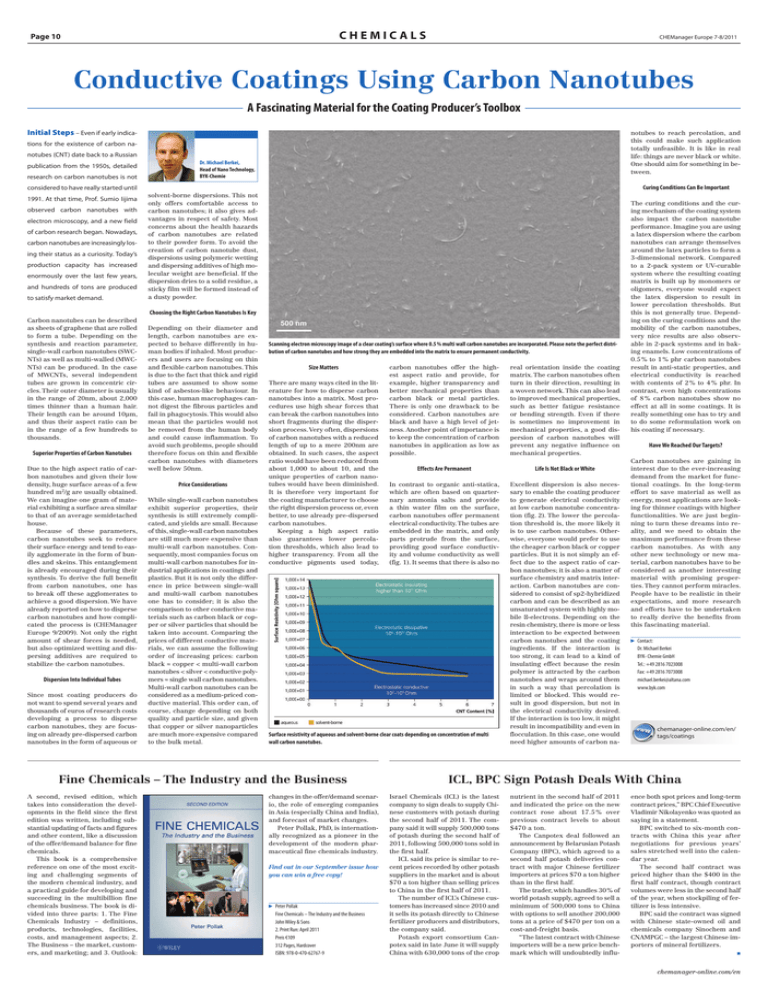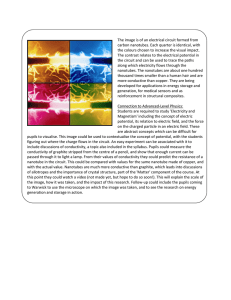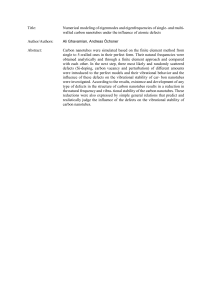Conductive Coatings Using Carbon Nanotubes
advertisement

Chemicals Page 10 CHEManager Europe 7-8/2011 Conductive Coatings Using Carbon Nanotubes A Fascinating Material for the Coating Producer’s Toolbox Initial Steps – Even if early indica- notubes to reach percolation, and this could make such application totally unfeasible. It is like in real life: things are never black or white. One should aim for something in between. tions for the existence of carbon nanotubes (CNT) date back to a Russian publication from the 1950s, detailed research on carbon nanotubes is not Dr. Michael Berkei, Head of Nano Technology, BYK-Chemie Curing Conditions Can Be Important considered to have really started until 1991. At that time, Prof. Sumio Iijima observed carbon nanotubes with electron microscopy, and a new field of carbon research began. Nowadays, carbon nanotubes are increasingly losing their status as a curiosity. Today’s production capacity has increased enormously over the last few years, and hundreds of tons are produced to satisfy market demand. solvent-borne dispersions. This not only offers comfortable access to carbon nanotubes; it also gives advantages in respect of safety. Most concerns about the health hazards of carbon nanotubes are related to their powder form. To avoid the creation of carbon nanotube dust, dispersions using polymeric wetting and dispersing additives of high molecular weight are beneficial. If the dispersion dries to a solid residue, a sticky film will be formed instead of a dusty powder. Choosing the Right Carbon Nanotubes Is Key Carbon nanotubes can be described as sheets of graphene that are rolled to form a tube. Depending on the synthesis and reaction parameter, single-wall carbon nanotubes (SWCNTs) as well as multi-walled (MWCNTs) can be produced. In the case of MWCNTs, several independent tubes are grown in concentric circles. Their outer diameter is usually in the range of 20nm, about 2,000 times thinner than a human hair. Their length can be around 10µm, and thus their aspect ratio can be in the range of a few hundreds to thousands. Superior Properties of Carbon Nanotubes Due to the high aspect ratio of carbon nanotubes and given their low density, huge surface areas of a few hundred m2/g are usually obtained. We can imagine one gram of material exhibiting a surface area similar to that of an average semidetached house. Because of these parameters, carbon nanotubes seek to reduce their surface energy and tend to easily agglomerate in the form of bundles and skeins. This entanglement is already encouraged during their synthesis. To derive the full benefit from carbon nanotubes, one has to break off these agglomerates to achieve a good dispersion. We have already reported on how to disperse carbon nanotubes and how complicated the process is (CHEManager Europe 9/2009). Not only the right amount of shear forces is needed, but also optimized wetting and dispersing additives are required to stabilize the carbon nanotubes. Dispersion Into Individual Tubes Since most coating producers do not want to spend several years and thousands of euros of research costs developing a process to disperse carbon nanotubes, they are focusing on already pre-dispersed carbon nanotubes in the form of aqueous or Depending on their diameter and length, carbon nanotubes are expected to behave differently in human bodies if inhaled. Most producers and users are focusing on thin and flexible carbon nanotubes. This is due to the fact that thick and rigid tubes are assumed to show some kind of asbestos-like behaviour. In this case, human macrophages cannot digest the fibrous particles and fail in phagocytosis. This would also mean that the particles would not be removed from the human body and could cause inflammation. To avoid such problems, people should therefore focus on thin and flexible carbon nanotubes with diameters well below 50nm. Price Considerations While single-wall carbon nanotubes exhibit superior properties, their synthesis is still extremely complicated, and yields are small. Because of this, single-wall carbon nanotubes are still much more expensive than multi-wall carbon nanotubes. Consequently, most companies focus on multi-wall carbon nanotubes for industrial applications in coatings and plastics. But it is not only the difference in price between single-wall and multi-wall carbon nanotubes one has to consider; it is also the comparison to other conductive materials such as carbon black or copper or silver particles that should be taken into account. Comparing the prices of different conductive materials, we can assume the following order of increasing prices: carbon black ≈ copper < multi-wall carbon nanotubes < silver < conductive polymers ≈ single wall carbon nanotubes. Multi-wall carbon nanotubes can be considered as a medium-priced conductive material. This order can, of course, change depending on both quality and particle size, and given that copper or silver nanoparticles are much more expensive compared to the bulk metal. Scanning electron microscopy image of a clear coating’s surface where 0.5 % multi wall carbon nanotubes are incorporated. Please note the perfect distribution of carbon nanotubes and how strong they are embedded into the matrix to ensure permanent conductivity. Size Matters There are many ways cited in the literature for how to disperse carbon nanotubes into a matrix. Most procedures use high shear forces that can break the carbon nanotubes into short fragments during the dispersion process. Very often, dispersions of carbon nanotubes with a reduced length of up to a mere 200nm are obtained. In such cases, the aspect ratio would have been reduced from about 1,000 to about 10, and the unique properties of carbon nanotubes would have been diminished. It is therefore very important for the coating manufacturer to choose the right dispersion process or, even better, to use already pre-dispersed carbon nanotubes. Keeping a high aspect ratio also guarantees lower percolation thresholds, which also lead to higher transparency. From all the conductive pigments used today, real orientation inside the coating matrix. The carbon nanotubes often turn in their direction, resulting in a woven network. This can also lead to improved mechanical properties, such as better fatigue resistance or bending strength. Even if there is sometimes no improvement in mechanical properties, a good dispersion of carbon nanotubes will prevent any negative influence on mechanical properties. Effects Are Permanent Life Is Not Black or White In contrast to organic anti-statica, which are often based on quarternary ammonia salts and provide a thin water film on the surface, carbon nanotubes offer permanent electrical conductivity. The tubes are embedded in the matrix, and only parts protrude from the surface, providing good surface conductivity and volume conductivity as well (fig. 1). It seems that there is also no Excellent dispersion is also necessary to enable the coating producer to generate electrical conductivity at low carbon nanotube concentration (fig. 2). The lower the percolation threshold is, the more likely it is to use carbon nanotubes. Otherwise, everyone would prefer to use the cheaper carbon black or copper particles. But it is not simply an effect due to the aspect ratio of carbon nanotubes; it is also a matter of surface chemistry and matrix interaction. Carbon nanotubes are considered to consist of sp2-hybridized carbon and can be described as an unsaturated system with highly mobile -electrons. Depending on the resin chemistry, there is more or less interaction to be expected between carbon nanotubes and the coating ingredients. If the interaction is too strong, it can lead to a kind of insulating effect because the resin polymer is attracted by the carbon nanotubes and wraps around them in such a way that percolation is limited or blocked. This would result in good dispersion, but not in the electrical conductivity desired. If the interaction is too low, it might result in incompatibility and even in flocculation. In this case, one would need higher amounts of carbon na- Surface resistivity of aqueous and solvent-borne clear coats depending on concentration of multi wall carbon nanotubes. Fine Chemicals – The Industry and the Business A second, revised edition, which takes into consideration the developments in the field since the first edition was written, including substantial updating of facts and figures and other content, like a discussion of the offer/demand balance for fine chemicals. This book is a comprehensive reference on one of the most exciting and challenging segments of the modern chemical industry, and a practical guide for developing and succeeding in the multibillion fine chemicals business. The book is divided into three parts: 1. The Fine Chemicals Industry – definitions, products, technologies, facilities, costs, and management aspects; 2. The Business – the market, customers, and marketing; and 3. Outlook: carbon nanotubes offer the highest aspect ratio and provide, for example, higher transparency and better mechanical properties than carbon black or metal particles. There is only one drawback to be considered. Carbon nanotubes are black and have a high level of jetness. Another point of importance is to keep the concentration of carbon nanotubes in application as low as possible. changes in the offer/demand scenario, the role of emerging companies in Asia (especially China and India), and forecast of market changes. Peter Pollak, PhD, is internationally recognized as a pioneer in the development of the modern pharmaceutical fine chemicals industry. Find out in our September issue how you can win a free copy! 22 Peter Pollak Fine Chemicals – The Industry and the Business John Wiley & Sons 2. Print Run: April 2011 Preis €109 312 Pages, Hardcover ISBN: 978-0-470-62767-9 The curing conditions and the curing mechanism of the coating system also impact the carbon nanotube performance. Imagine you are using a latex dispersion where the carbon nanotubes can arrange themselves around the latex particles to form a 3-dimensional network. Compared to a 2-pack system or UV-curable system where the resulting coating matrix is built up by monomers or oligomers, everyone would expect the latex dispersion to result in lower percolation thresholds. But this is not generally true. Depending on the curing conditions and the mobility of the carbon nanotubes, very nice results are also observable in 2-pack systems and in baking enamels. Low concentrations of 0.5 % to 1 % phr carbon nanotubes result in anti-static properties, and electrical conductivity is reached with contents of 2 % to 4 % phr. In contrast, even high concentrations of 8 % carbon nanotubes show no effect at all in some coatings. It is really something one has to try and to do some reformulation work on his coating if necessary. Have We Reached Our Targets? Carbon nanotubes are gaining in interest due to the ever-increasing demand from the market for functional coatings. In the long-term effort to save material as well as energy, most applications are looking for thinner coatings with higher functionalities. We are just beginning to turn these dreams into reality, and we need to obtain the maximum performance from these carbon nanotubes. As with any other new technology or new material, carbon nanotubes have to be considered as another interesting material with promising properties. They cannot perform miracles. People have to be realistic in their expectations, and more research and efforts have to be undertaken to really derive the benefits from this fascinating material. 22 Contact: Dr. Michael Berkei BYK- Chemie GmbH Tel.: +49 2816 7023008 Fax: +49 2816 7073008 michael.berkei@altana.com www.byk.com chemanager-online.com/en/ tags/coatings ICL, BPC Sign Potash Deals With China Israel Chemicals (ICL) is the latest company to sign deals to supply Chinese customers with potash during the second half of 2011. The company said it will supply 500,000 tons of potash during the second half of 2011, following 500,000 tons sold in the first half. ICL said its price is similar to recent prices recorded by other potash suppliers in the market and is about $70 a ton higher than selling prices to China in the first half of 2011. The number of ICL’s Chinese customers has increased since 2010 and it sells its potash directly to Chinese fertilizer producers and distributors, the company said. Potash export consortium Canpotex said in late June it will supply China with 630,000 tons of the crop nutrient in the second half of 2011 and indicated the price on the new contract rose about 17.5 % over previous contract levels to about $470 a ton. The Canpotex deal followed an announcement by Belarusian Potash Company (BPC), which agreed to a second half potash deliveries contract with major Chinese fertilizer importers at prices $70 a ton higher than in the first half. The trader, which handles 30 % of world potash supply, agreed to sell a minimum of 500,000 tons to China with options to sell another 200,000 tons at a price of $470 per ton on a cost-and-freight basis. “The latest contract with Chinese importers will be a new price benchmark which will undoubtedly influ- ence both spot prices and long-term contract prices,” BPC Chief Executive Vladimir Nikolayenko was quoted as saying in a statement. BPC switched to six-month contracts with China this year after negotiations for previous years’ sales stretched well into the calendar year. The second half contract was priced higher than the $400 in the first half contract, though contract volumes were less in the second half of the year, when stockpiling of fertilizer is less intensive. BPC said the contract was signed with Chinese state-owned oil and chemicals company Sinochem and CNAMPGC – the largest Chinese importers of mineral fertilizers. J chemanager-online.com/en




